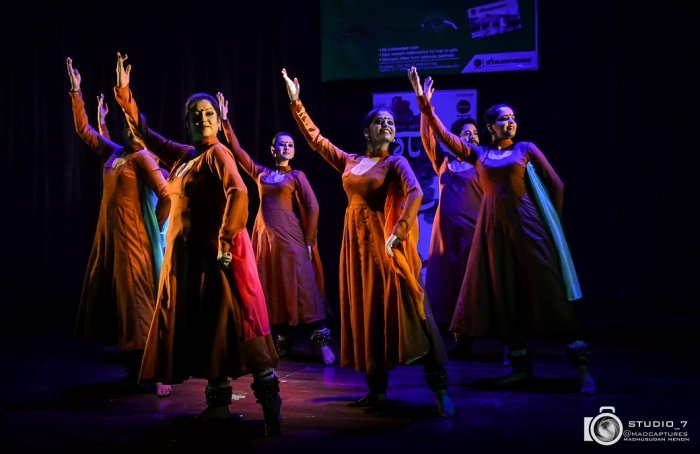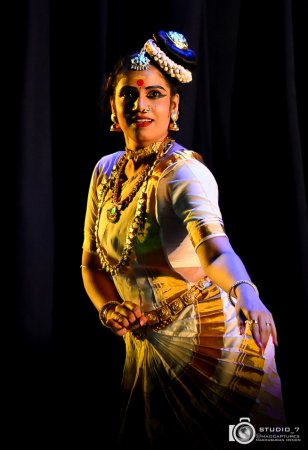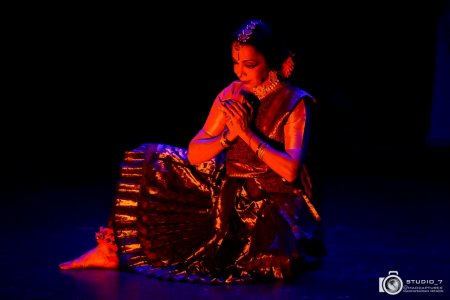
|   |

|   |
Rang: Seven colors and four classical styles etch oneness Pics: Madhusudan S Menon March 21, 2020 An interesting definition of Colors - Rang, conceptualized by curator Manisha Jeet, an established Kathak exponent / teacher was presented as part of the second edition of NCPA Mumbai Dance Season at the mini theatre of Rabindra Natya Mandir, Mumbai. The vibrancy of colors and their reflected qualities adding zest to life's unfolding drama was presented by Manisha Jeet with her disciples and Ankit Pahadia who defined orange, green, red, blue and white. Pink was sheathed in the graceful classical style of Mohiniattam by Sujata Nair, disciple of Guru Jayashree Nair (Upaasana Academy of Dance & Music). Black and yellow was defined by Bharatanatyam exponent Dr. Lata Surendra. Using drapes in the varying colours that she sought to define, Manisha Jeet used the potency of Kathak to bring alive her theme.  Manisha Jeet & disciples Orange, the colour of enthusiasm, determination, success and encouragement was epitomized through the strength and endurance of Chhatrapati Shivaji Maharaj - the great Maratha warrior and the founder of Hindavi Swaraj. The colour proudly embodied on the Indian National Flag - Tiranga, as stimulating each human to leave a mark in this world with courage and tenacity was executed with energy by Jeet's disciples. Green, the defining colour of growth and harmony enveloping peace and happiness around was highlighted uniquely through Haji Ali, a Sufi saint in whose memory the pristine Dargah stands in the Indian part of the Arabian Sea in Mumbai. The subtle choreography haunting with the essence of sufi music stirred hearts to awaken all to that peace vital in today's world of breaking news. If green was the colour of serenity, then blue as the Bible refers to, signifies the healing power of god and the Kathak dancers stirred a divinity in each of the rasikas to emulate messiahs and seek to awaken all to the truth that service to humanity was service to god. Red as the colour of blood, the colour of martyrs, the colour of fire was very symbolically and dramatically highlighted through the fire and courage of Abhimanyu, the brave son of Arjuna who fought valiantly in the battle of Kurukshetra. Drawing parallels to the reviving inner fire that has a Phoenix falling and turning into ash and yet rises again with renewed life, the choreography reflected Abhimanyu's inner fire that had him fall to the ground to resurrect as an eternal hero who lived on in the hearts of generations to come. Ankit Pahadia as Abhimanyu was energy incarnate. He displayed his mastery over his technique that with skill gathered the synergy of the western ballet and eastern martial arts, particularly the Mayurbhanj Chhau dance from Orissa. It was interesting to see two classical styles come together imaginatively to define red. White as having the capacity to encompass anything and everything through its exuding peace was defined through winter season Shishir, wherein with imagination Manisha Jeet used poetry, lyrics and commentary to drive home the canvas of winter that concluded with the beautiful message that highlighted the cyclic pattern of nature and the transience of every unfolding seasonal canvas. The message had one recall Shelley's oft quoted line, "If winter comes, can spring be far behind." Manisha Jeet with her disciples Ashwene Vij, Rohini Vij, Omkar Chitnis, with well coordinated moves visually painted orange, green, red, white, blue through the kinesthetic of Kathak.  Sujata Nair Pink was sheathed in the graceful classical style of Mohiniattam by Sujata Nair. Relating it to love, Sujatha brought to life Swathi Tirunal's "Chaliye kunjan mo." Her eloquent eyes urging Krishna to an arbor on the banks of the Yamuna river brought to life that Radha is sometimes flushed with an innate modesty, painting her cheeks with pink as she reached out for Krishna's hand to lead him towards herself! Brash yet shy, it was a Radha who had all hearts go out to her, as she drew attention to the beauty of creation that was unfolding with the heaving Yamuna river, the call of the koel, the heady intoxication of the breeze carrying the fragrance of blossoms around. Flushed with love here was a pink that danced into hearts through the poetry of sambhoga -sringaram. Kudos to her mentor for imaginatively leading the dancer into coloring essence of a pink pulsating with love in the valentine month of February.  Lata Surendra Then came the color yellow and black that Lata Surendra presented with 'Pratyaya -Cause.' Colouring the cause with yellow, she vividly etched through Bharatanatyam, the symbolic creation of Ganesa with haridri, by the all merciful one - Parvati. Breathing the life-force into the endearing form she skillfully showed the child being led into movements through the potent folds of nritta and nritya. The endearing form of Ganesa keeping watch, soon sets the pace for the entry of Lord Shiva. His amusement as the little Ganesa obstructs his path transforms to a rage that effects the head of the child being cut off. A pratyaya-cause then has rage transform to dark fury in Parvati. Even as the merciful mother transforms to the merciless all prakriti comes to naught in that black dark night that eclipses even the day until the cherubic hands of her son, resurrected with the elephant head by his father Lord Shiva, embraces her motherhood. Absorbing in its layering with a music that complimented each changing mood and character, the choreography through the vivid folds of yellow and black, etched Pratyaya evocatively. It is said that in duality we as humans remain lost to each other but in oneness we find us in each other and the climax was indeed a fitting finale, with all dancers bringing to life 'avagha rang jhala' written by Sant Soyarabai - the wife of better-known Dalit saint-poet Chokhamela. "Though you are embodied you are formless. I awaken to the truth that .... There remains no difference between the spectator and the gaze..." With the synergy of seven colors and four classical styles, Rang truly balanced the odds and evens in the non-duality of oneness. |